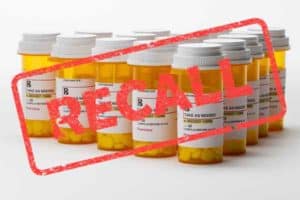Was There a Valsartan Cancer Lawsuit?
Valsartan cancer lawsuits were previously filed after it was discovered that certain generic versions of the blood pressure medication were contaminated with N-nitrosodimethylamine (NDMA), a probable human carcinogen linked to an increased risk of liver, colorectal, stomach, and other cancers.
Valsartan cancer risks first arose in 2018, when the U.S. Food and Drug Administration (FDA) announced several Valsartan recalls following the discovery that changes in the manufacturing process of the active pharmaceutical ingredient had led to the formation of NDMA impurities. Although contamination was identified in 2018, potentially affected valsartan products had been on the market since as early as 2012, exposing some users to the cancer-causing compound.
As a result, both individual lawsuits and class actions were filed against multiple pharmaceutical manufacturers, alleging that exposure to contaminated valsartan contributed to cancer diagnoses and that the companies failed to ensure the safety and purity of their drugs.
Claims were previously reviewed on behalf of individuals who used recalled valsartan and were later diagnosed with:
- Bladder Cancer
- Colon Cancer
- Colorectal Cancer
- Esophageal Cancer
- Intestinal Cancer
- Leukemia
- Liver Cancer
- Lung Cancer
- Multiple Myeloma
- Non-Hodgkins Lymphoma
- Prostate Cancer
- Rectal Cancer
- Small Intestine Cancer
- Stomach or Gastric Cancer
Info About Valsartan Cancer Lawsuits On This Page
Valsartan NDMA Recall Timeline
Link Between Valsartan and Cancer Side Effects
Valsartan Cancer Lawsuit Multidistrict Litigation
Valsartan Class Action Lawsuit
Valsartan Lawsuit Updates
- November 2025 Update: The federal Valsartan multidistrict litigation is now in its final stages, with most claims resolved or set for individual resolution following years of coordinated proceedings. New case filings have largely ceased due to elapsed filing deadlines and strict product-identification requirements. As of October 2025, Saiontz & Kirk is no longer reviewing new Valsartan claims.
- February 2024 Update: The U.S. JPML issued a new multidistrict litigation statistics report this month indicating there are a total of 1,226 valsartan lawsuits actively pending in the Valsartan, Losartan, and Irbesartan Products Liability Litigation as of February 1, 2024, with the potential for hundreds of additional claims to come forth throughout 2024.
- December 2023 Update: The federal judge presiding over the Valsartan MDL certified three classes of plaintiffs including Consumer Economic Loss, Medical Monitoring, and Third Party Payor (“TPP”) Class, as well as some some subclasses in the valsartan litigation.
- December 2022 Update: The U.S. District Judge overseeing valsartan NDMA lawsuits denied a renewed request by defendants to exclude plaintiffs’ expert witnesses, despite a recent order dismissing Zantac lawsuits involving the same cancer-causing contaminant. Defendants sought reconsideration, citing flaws highlighted in a related case, or certification for interlocutory appeal. However, Judge Kugler swiftly rejected the motion in an order (PDF), emphasizing that there is “no scientific doubt about the presence of nitrosamines in the human body upon ingestion of the ‘valsartan-containing drugs containing NDMA or NDEA’ (VCDs) because the VCDs contained nitrosamine before ingestion”.
- March 2022 Update: In a case management order (PDF) dated March 3, Judge Kugler appointed retired U.S. District Judges Gregory M. Sleet and Lawrence F. Stengel as settlement special masters in the valsartan litigation. Their role is to lead advanced valsartan settlement negotiations, aiming to resolve the litigation without the necessity of numerous trials.
- December 2020 Update: The judge presiding over the valsartan MDL denied several motions to dismiss from defendant drug manufacturers, rejecting arguments claiming federal preemption under the Federal Food, Drug, and Cosmetic Act, signaling the court’s determination to proceed with the litigation.
- December 2019 Update: A federal panel of judges decided to consolidate all losartan and irbesartan lawsuits from U.S. District Courts with the ongoing valsartan litigation. This decision was made due to the similar allegations across these cases, involving contamination of generic blood pressure drugs with cancer-causing chemicals.
- February 2019 Update: The U.S. Judicial Panel on Multidistrict Litigation (JPML) issued a transfer order on February 14, 2019, centralizing all valsartan cancer lawsuits filed in federal courts nationwide before U.S. District Judge Robert B. Kugler in the District of New Jersey for pretrial proceedings.
Valsartan NDMA Recall Timeline

August 2002
Valsartan approved for treatment of hypertension under brand name Diovan
2014
First generic valsartan introduced in the United States
2015-2018
Reports involving valsartan and cancer diagnosed among users surface.
July 2018
FDA and European regulators recall Valsartan distributed by several drug makers.
Valsartan and valsartan HCTZ are drugs that are used to treat high blood pressure that were first sold under the brand name Diovan. However, in recent years, prescriptions are typically filled with generic equivalents that are now sold by a number of different drug makers.
Concerns about the link between side effects of valsartan and cancer first emerged in early July 2018, after it was discovered that active ingredients supplied by Zhejiang Huahai Pharmaceuticals in China, tested positive for NDMA, which is known to pose serious health side effects, including an increased risk of cancer.
It was subsequently discovered that the certain versions of the hypertension drug were contaminated for years, exposing users to an increased risk of cancers as the chemicals travel through the body.
On July 13, the FDA announced valsartan recalls impacting pills sold by Major Pharmaceuticals, Solco Healthcare, Teva Pharmaceuticals, and Prinston Pharmaceuticals.
A few weeks later, the recall was expanded to include some or all versions of valsartan distributed by certain repackagers, including:
- A-S Medication Solutions LLC
- AvKARE
- RemedyRepack
- Bryant Ranch Prepack Inc.
- H.J. Harkins Company, Inc.
- Lake Erie Medical, doing business as Quality Care Products LLC
- NuCare Pharmaceuticals
- Proficient Rx
According to FDA investigators, NDMA in valsartan appears to be a byproduct and impurity resulting from the manufacturing process. Evidence suggests that contaminated versions of valsartan medications have been distributed for at least four years, and that the risk of cancer from valsartan may continue for years after last use of the recalled pills.
Link Between Valsartan and Cancer Side Effects
NDMA has been a known human carcinogen since at least 2005. The EPA has set a maximum daily limit of 96 nanograms of NDMA per day. However, recalled valsartan pills may have had levels of NDMA that exceed those safe limits, according to the FDA.
It appears that the manufacturers of generic valsartan failed to conduct adequate testing to ensure that the drugs were safe for consumers before being introduced to the valsartan supply chain, potentially exposing them to a cancer-causing agent for years.
Valsartan Cancer Lawsuit Multidistrict Litigation
Shortly after the series of Valsartan recalls were issued, a growing number of valsartan class action lawsuits and individual valsartan cancer lawsuits were filed against the drug manufacturers, pharmacies and other entities throughout the federal court system, each raising similar questions of fact that valsartan pills were sold for years with a cancer-causing impurity that can increase the risk of cancer.
In response to the growing number of claims, the U.S. Judicial Panel on Multidistrict Litigation (JPML) issued a transfer order (PDF) in October 2018, ordering all valsartan cases pending throughout the federal court system to centralized before U.S. District Judge Robert B. Kugler in the District of New Jersey as part of a consolidated valsartan litigation.
In complex product liability litigation, where a large number of individuals are pursuing claims involving the same or similar allegations, it is common for the U.S. JPML to centralize similar cases from various jurisdictions to streamline pretrial proceedings and promote efficiency in the legal process. Centralizing these cases allows for consistent management and facilitates coordination among parties involved in the litigation.
Valsartan Class Action Lawsuit
A federal court in New Jersey approved a class action lawsuit against several generic valsartan manufacturers. This lawsuit was not just for people who developed cancer but also for those who purchased the contaminated drugs but haven’t developed cancer (yet) and for the health insurance plans that paid for these medications.
The plaintiffs in these class action lawsuits sought refunds for buying the potentially harmful medicines and also requested that drug companies cover the costs of medical monitoring, such as cancer screening, for those who were exposed to the contaminated drugs.
The companies that produced the contaminated valsartan pills opposed the formation of these class action lawsuits, arguing that they were too complex and difficult to manage. However, the court disagreed with their arguments and certified the class actions, allowing the lawsuits to move forward.
Who was eligible for the Valsartan Class Action Lawsuit?
The valsartan class action lawsuit encompassed various classes of individuals and entities affected by the distribution and consumption of valsartan-containing drugs. The three descriptions of class members in the lawsuit included a consumer economic loss class, medical monitoring class, and a third party payer class.
Consumer Economic Loss Class
This includes all individuals in the United States and its territories who have paid for a valsartan-containing medication made, distributed, or sold by any defendant from January 1, 2012, up to the final recall date of November 10, 2021.
Medical Monitoring Class
This applied to people living in the United States and its territories and possessions (except for Mississippi, New Hampshire, North Carolina, and North Dakota) who ingested a high cumulative lifetime amount of NDMA or NDEA from generic valsartan-containing medications.
These medications must have been made by any defendant responsible for producing the active pharmaceutical ingredients or finished doses and have been available in the United States and its territories since January 1, 2012, at the earliest.
Third Party Payer Class
This encompassed all third-party payors or any organization that paid money in the United States for contaminated valsartan medications between January 1, 2012, and November 10, 2021, from specific manufacturers or sellers.

